Get a model and concrete steps to steer conversations and meetings safely to the finish line
Are you often faced with managing a dialog or meeting safely to the finish line, possibly as part of a larger change process? Then the gamemaster model, which is a model from the world of coaching that covers a set of conversational skills, can help.
Gamemaster skills are fundamentally about developing an eye for what is being said and how what is being said moves the conversation in a particular direction. And based on this, being able to adjust the conversation or process back on track. It is a fundamental and indispensable skill for anyone responsible for a conversation, meeting or process.
In this article, you will first be introduced to the gamemaster model, followed by an unfolding of the practical application of the model, and finally some typical challenges and points of attention when working with gamemaster skills.
Learn more about change management through our knowledge universe
In most organizations, creating change and development is an ongoing challenge. Whether it's time pressure, process fatigue or resistance to change that makes it difficult to reach the finish line.
On this page you can find some of our articles and videos on the topic. Read along and get input on how to succeed with change management.
The Gamemaster model
In every conversation (and every process) there is a content level as well as a process level. That is, a difference between what is said - and how what is said moves the conversation in a particular direction. The Gamemaster skill is to be aware of both and to be able to intervene if communication is moving in an inappropriate direction. Most often, this will be done by slowing down the conversation at the content level and instead focusing attention on the process level - what in coaching terminology is called "going meta on the conversation" or "talking about the conversation".
In the gamemaster model, it is illustrated in this way:

Contract: Set the stage for the conversation
The contract is where the stage is set for the conversation. It's where you coordinate expectations with each other about what the framework of the conversation is: Is it a brief exchange of ideas, or do we sit down to talk more deeply about a topic? Is there a goal or something specific we want to achieve with the conversation, or is it a looser, more exploratory conversation? Is there something that has prompted the conversation? Are there other stakeholders who have expectations of what we will achieve in this conversation? What expectations and/or roles do we each have in the conversation? Etc.
The contract frames and aligns a shared understanding of what will happen next. The intention is to give all participants the best possible conditions for decoding how they can best and most relevantly contribute to the dialog.
Time out: An indispensable tool
As we all know, conversations and meetings often have a life of their own and will evolve in directions you didn't anticipate or expect from the start. That's why time out is an indispensable tool. The time out will be expressed as a series of reflections on how the conversation is developing: Are we on the right track? Are we talking about the same thing? Is what we agreed at the start still important? What have we achieved and what do we need to achieve? Are we operating from the same understanding? Could we try to approach it in different ways? Is it appropriate to continue the conversation on this track or should we switch? If so, to what and how?
When you, as a process leader in the conversation, feel these questions rumbling in your head, gamemasters will often choose to bring them explicitly into the shared dialog, thereby sharing the responsibility for making the conversation create the difference it potentially could.
It is especially in connection with the timeout that the meeting leader's ability to pay double attention to both content and process is challenged. A timeout can manifest itself in two ways: Firstly, as an outright interruption of the conversation about the case to instead talk about the conversation (as in the examples above). And secondly, as ongoing considerations that the moderator makes as a starting point for intervening in the conversation and getting it back on track. There are a number of factors at play here, which we will briefly discuss at the end of the text.
The contract frames and aligns a shared understanding of what will happen next. The intention is to give all participants the best possible conditions for decoding how they can best and most relevantly contribute to the dialog.
Closing: Summarize the outcome
Closure as a communicative device covers an awareness that, as part of the conversation (or meeting or process), time must be spent gathering and establishing a shared understanding of what has been achieved. Most people will be familiar with the feeling of leaving a meeting or conversation unsure of what was actually achieved and whether a decision was made. In some situations this may be ok, but in others it will result in a sense of wasted time and frustration.
The ending is a way to avoid this: So what have we arrived at? What has become clearer now than before the conversation? Where are we now in relation to the topic? How do we move forward? What is the next step? Etc.
Read more about our training
Want to be even better equipped to manage processes?
The Process Consultant program gives you the methods to design, facilitate and lead strategic development processes and changes to create the impact you need.
This is an education for those who work with development, processes and change management.
How to put the model into practice
As a hypothetical example, let's take a project steering committee meeting to evaluate the progress of the project and decide on the next steps.
A good meeting starts with a good meeting invitation: What is the purpose of the meeting, what do we need to achieve during the meeting, what type of meeting is it (decision-making meeting, briefing meeting, idea development meeting)?

With this as a starting point, the meeting leader can set up a contract for the meeting, for example with these formulations:
- "What we're doing today is ... (referring to the meeting notice)"
- "I suggest we start by taking stock together of where we are in the project and then explore the immediate challenges we face."
- We have an hour and a half available, and it's important that we also reach (xx). Therefore, we'll finish the first part at approximately (xx) and move on to (xx). Are you with me?
Then the dialog is set free at the content level and the meeting participants contribute. Along the way, there will often be a need for timeouts, either in the form of partial summaries:
- So we agree that...
- Ok, moving on. The next step is to clarify...
Timeouts can also be formulated as re-focusing the meeting if the discussion is moving in different directions than agreed:
- Do we agree on what we're talking about? It sounds like we're talking about two different things...
- Now we are starting to open up for (xx), and not because it's not important, but if we are to reach the goal of this meeting, we have to park it for now.
When the meeting is coming to an end, there is a need for closure:
- So what is the most important thing we decided at this meeting?
- What do we do from here?
- What agreements have we made?
Depending on the nature of the meeting, it can be an advantage to end by asking the participants: Is there anything important that we have discussed that has not been included in this summary? And then take a round where everyone (who wants to) can have the opportunity to offer closing remarks.
Reflections on the practical use of the gamemaster model
With this example, it may sound very simple to steer a dialog towards goals. As most people will know, this is not always the case. During the course of the meeting, disagreements or even minor disagreements about the correct approach to what's being discussed are likely to arise. This is where the gamemaster comes into play: What exactly is it that you disagree on? What are the understandings behind why the meeting participants say what they do? What are they fighting for or want to defend?
Keep the conversation on track - and be inclusive
As employees, we often have something at stake professionally or personally when we present our views or argue for something. So when the gamemaster notices disagreements through their ongoing meta-considerations, it's important to keep your tongue firmly in your cheek so that you don't disavow any participants in your timeout formulation by implicitly denying their input - or by indirectly emphasizing someone's input at the expense of others.
Keeping the conversation on track while allowing everyone to feel like legitimate participants in the meeting (and project) is a complex balance. Recognition and professional self-narratives are at stake. This balance should also be reflected in the closing, where elements of everyone's input are brought in as much as possible.
A popular image of the gamemaster is the referee in a football match. The better the referee, the less focus on her and more on the game. But in situations of doubt, they intervene quickly and clearly to get the game back on track. It's hardly something you learn overnight. But it's worth the effort.




